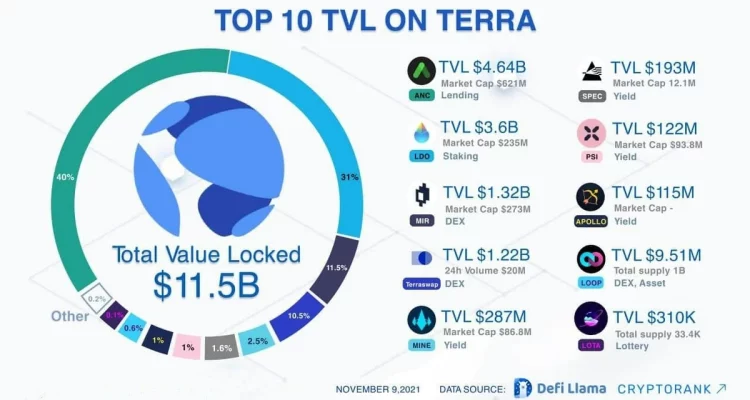Explore the Terra ecosystem in intimate detail with this comprehensive map.
Today, we’re going to explore the Terra Ecosystem map in great detail so that you can brush up on your navigational skills.
Terra has become a premier crypto project since its launch last year. It has developed several new projects and tokens, including Mirror, Anchor, Terraswap, Pylon Protocol, Mars Protocol, and more. All of these services are decentralized and focus on different aspects of the ecosystem such as payments or banking.
To make it easier to keep up with, @theericstone, Joan Kallogjeri, and @laurenbeltramo created this map of the ecosystem. Let’s take a closer look.
The Terra ecosystem map is divided into four categories, which are based on the four types of operations that members of the ecosystem provide. These operations are: core functionality, applications, governance and swaps and exchanges.
The four categories are based on a central node: Terra Chain Operation. This contains LUNA, the native staking token for Terra, and other Stablecoins pegged to various global currencies.
There are two main types of Chain Operation: delegated proof of stake details, and basic transfers and transactions.
Delegated proof of stake validation is what ensures the security of Terra. Delegators are those who stake LUNA to Validators, and in return earn rewards across all native Terra currencies. The daily reward summary represents these earned rewards.
Basic transfers and transactions for Native Tokens are carried out by terra.transfers, while those for other tokens and related transactions are handled by terra.msgs and terra.msg_events respectively.
The three aspects of Terra’s ecosystem are Transaction Fees, Prices, and Historical Balances.
The gas and taxes included in a transaction fee can be found in the Daily Fee Summary. However, if you’re looking for the current Oracle Exchange Rate, which updates every 5 blocks and includes native token prices, you’ll need to check out the Prices tab.
Lastly, we have Historical Balances. This can be separated into two sections- balances for LUNA and other stablecoins, as well as token balances. The former can show how much liquidity is available by label, while the latter displays information on things like the amount of bLUNA supplied on Anchor.
The three parts of a Terra ecosystem application are Contracts, Messaging, and Events. The app and smart contract development system in Terra, called Wasm, emits two types of message payloads: terra.msgs and terra.msg_events.
Some of the most well-known applications in Terra’s ecosystem are Chai, Mirror, and Anchor. With Chai, users can buy goods and services using KRT. Through Mirror, yield farmers can mint/burn synthetic assets and stake liquidity tokens to Passive Income Streams. Lastly, with Anchor lenders & borrowers(borrow UST) gain interest from their provided bLUNA token collateral.
There are two types of swaps and exchanges: Native Swapping and Terraswap Swapping.
Native Swapping refers to the native swapping of tokens between Stablecoins and LUNA, which can be represented by Daily Swap Volume per token type. Terraswap Swapping allows for liquidity pooling so that any two Terra assets may be exchanged. This is reflected in the number of Liquidity Events or daily UST/LUNA swap volume.
Lastly, we manage the Terra ecosystem through submitting and voting on proposals as well as having a say in how said votes are executed.
In order to submit a proposal, users must deposit 512 LUNA coins into their address. Once the proposals have been submitted, users are then able to vote on them. When delegating LUNA to Validators, this gives the Validators voting power.
